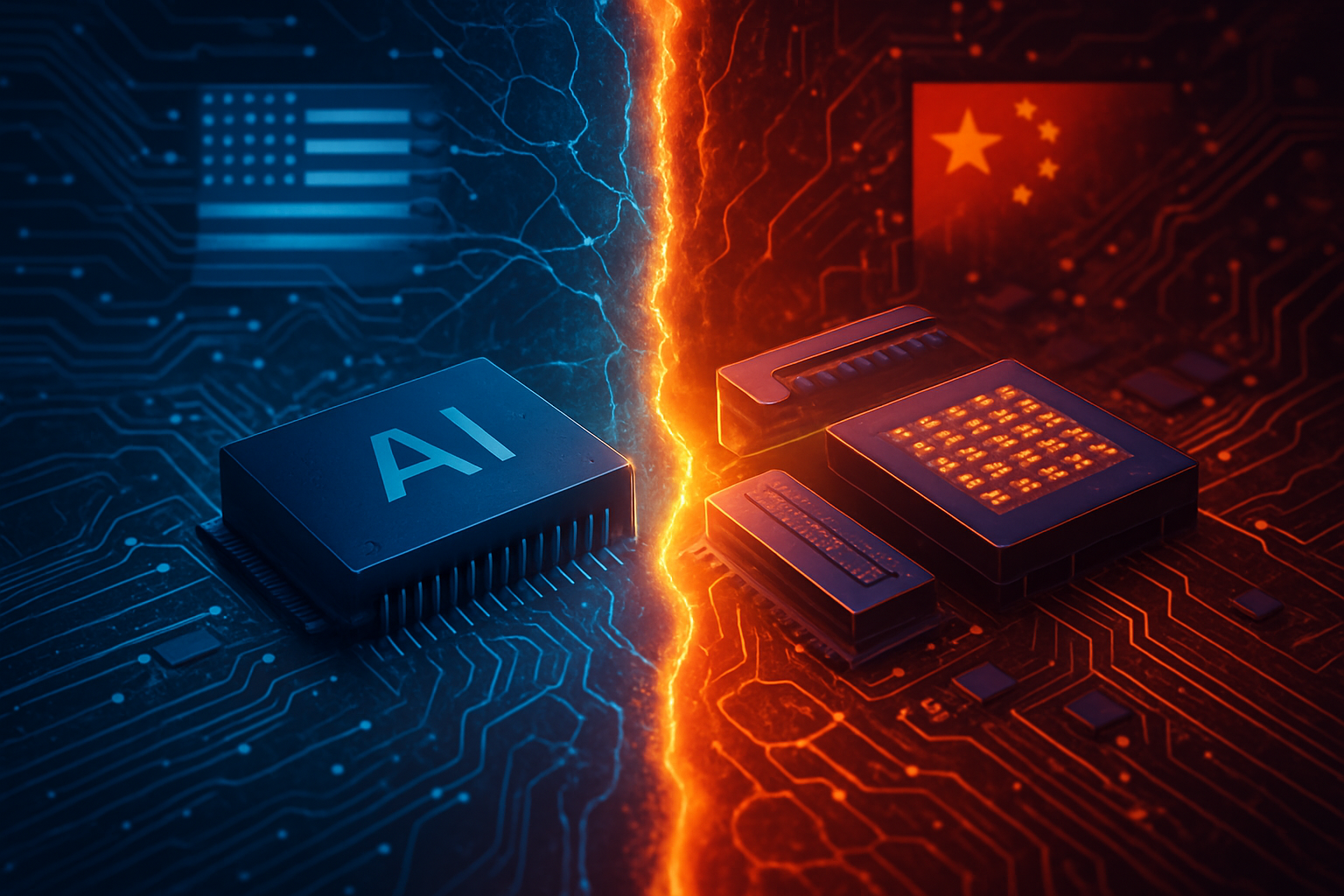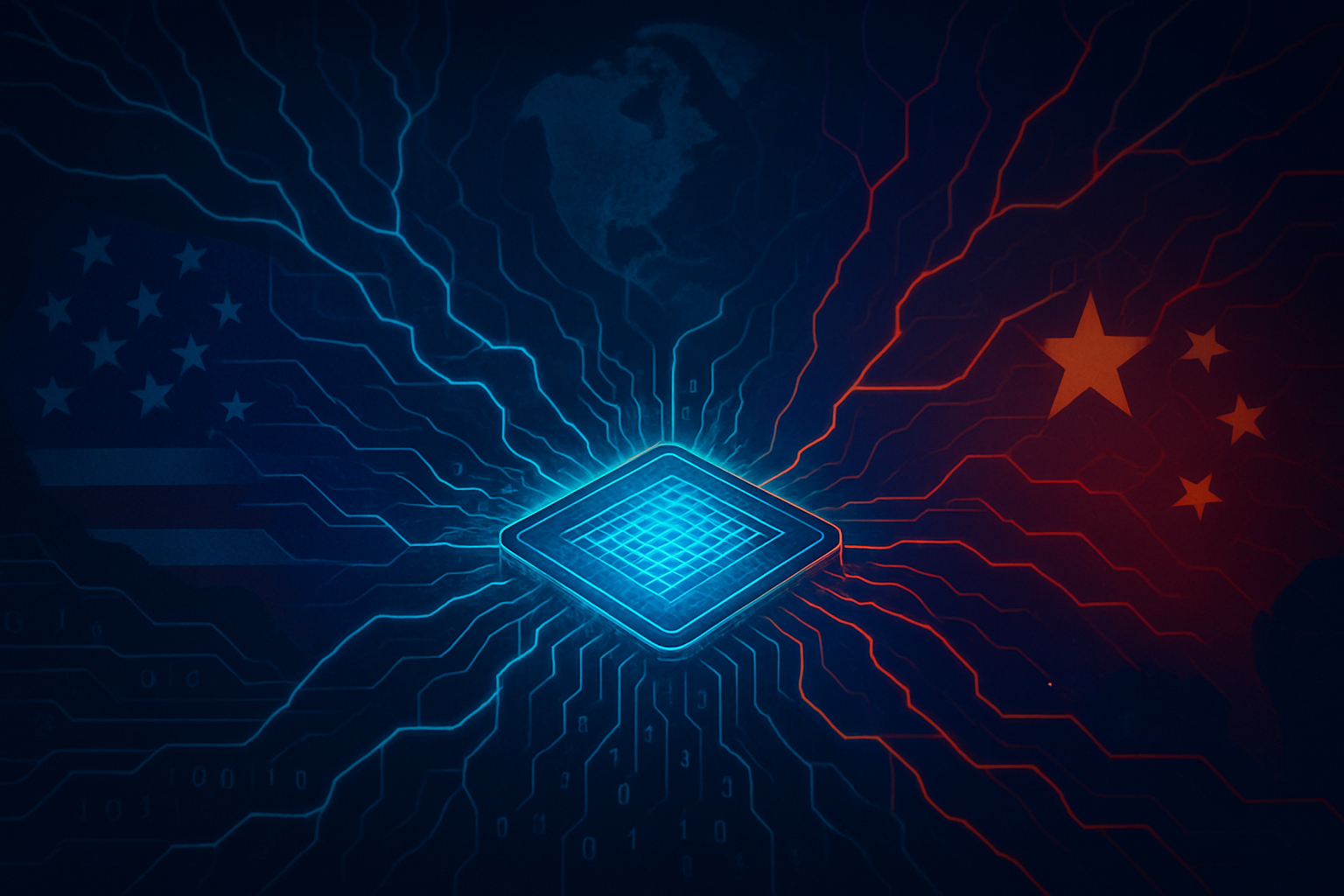The intricate web of the global semiconductor industry, long a bastion of international collaboration and efficiency, is increasingly being torn apart by escalating geopolitical tensions, primarily between the United States and China. This struggle, often termed a "tech cold war" or "silicon schism," centers on the pursuit of "tech sovereignty"—each nation's ambition to control the design, manufacturing, and supply of the advanced chips that power everything from artificial intelligence (AI) to military systems. The immediate significance of this rivalry is profound, forcing a radical restructuring of global supply chains, redefining investment strategies, and potentially altering the pace and direction of technological innovation worldwide.
At its core, this competition is a battle for technological dominance, with both Washington and Beijing viewing control over advanced semiconductors as a critical national security imperative. The ramifications extend far beyond the tech sector, touching upon global economic stability, national defense capabilities, and the very future of AI development.
The Crucible of Control: US Export Curbs and China's Quest for Self-Reliance
The current geopolitical climate has been shaped by a series of aggressive policy maneuvers from both the United States and China, each designed to assert technological control and secure strategic advantages.
The United States has implemented increasingly stringent export controls aimed at curbing China's technological advancement, particularly in advanced computing and AI. These measures, spearheaded by the US Department of Commerce's Bureau of Industry and Security (BIS), target specific technical thresholds. Restrictions apply to logic chips below 16/14 nanometers (nm), DRAM memory chips below 18nm half-pitch, and NAND flash memory chips with 128 layers or more. Crucially, these controls also encompass advanced semiconductor manufacturing equipment (SME) necessary for producing chips smaller than 16nm, including critical Deep Ultraviolet (DUV) lithography machines and Electronic Design Automation (EDA) tools. The "US Persons" rule further restricts American citizens and green card holders from working at Chinese semiconductor facilities, while the "50 Percent Rule" expands the reach of these controls to subsidiaries of blacklisted foreign firms. Major Chinese entities like Huawei Technologies Co., Ltd. and Semiconductor Manufacturing International Corporation (SMIC), China's largest chipmaker, have been placed on the Entity List, severely limiting their access to US technology.
In direct response, China has launched an ambitious, state-backed drive for semiconductor self-sufficiency. Central to this effort is the "Big Fund" (National Integrated Circuit Industry Investment Fund), which has seen three phases of massive capital injection. The latest, Phase III, launched in May 2024, is the largest to date, amassing 344 billion yuan (approximately US$47.5 billion to US$65.4 billion) to bolster high-end innovation and foster existing capabilities. This fund supports domestic champions like SMIC, Yangtze Memory Technologies Corporation (YMTC), and ChangXin Memory Technologies (CXMT). Despite US restrictions, SMIC reportedly achieved a "quasi-7-nanometer" (7nm) process using DUV lithography by October 2020, enabling the production of Huawei's Kirin 9000S processor for the Mate 60 Pro smartphone in late 2023. While this 7nm production is more costly and has lower yield rates than using Extreme Ultraviolet (EUV) lithography, it demonstrates China's resilience. Huawei, through its HiSilicon division, is also emerging as a significant player in AI accelerators, with its Ascend 910C chip rivaling some of NVIDIA Corp. (NASDAQ: NVDA)'s offerings. China has also retaliated by restricting the export of critical minerals like gallium and germanium, essential for semiconductor production.
The US has also enacted the CHIPS and Science Act in 2022, allocating approximately US$280 billion to boost domestic research and manufacturing of semiconductors. This includes US$39 billion in subsidies for chip manufacturing on US soil and a 25% investment tax credit. Companies receiving these subsidies are prohibited from producing chips more advanced than 28nm in China for 10 years. Furthermore, the US has actively sought multilateral cooperation, aligning allies like the Netherlands (home to ASML Holding N.V. (NASDAQ: ASML)), Japan, South Korea, and Taiwan in implementing similar export controls, notably through the "Chip 4 Alliance." While a temporary one-year tariff truce was reportedly agreed upon in October 2025 between the US and China, which included a suspension of new Chinese measures on rare earth metals, the underlying tensions and strategic competition remain.
Corporate Crossroads: Tech Giants Navigate a Fragmented Future
The escalating US-China semiconductor tensions have sent shockwaves through the global tech industry, forcing major companies and startups alike to re-evaluate strategies, reconfigure supply chains, and brace for a bifurcated future.
NVIDIA Corp. (NASDAQ: NVDA), a leader in AI chips, has been significantly impacted by US export controls that restrict the sale of its most powerful GPUs, such as the H100, to China. Although NVIDIA developed downgraded versions like the H20 to comply, these too have faced fluctuating restrictions. China historically represented a substantial portion of NVIDIA's revenue, and these bans have resulted in billions of dollars in lost sales and a decline in its share of China's AI chip market. CEO Jensen Huang has voiced concerns that these restrictions inadvertently strengthen Chinese competitors and weaken America's long-term technological edge.
Intel Corp. (NASDAQ: INTC) has also faced considerable disadvantages, particularly due to China's retaliatory ban on its processors in government systems, citing national security concerns. With China accounting for approximately 27% of Intel's annual revenue, this ban is a major financial blow, compelling a shift towards domestic Chinese suppliers. Despite these setbacks, Intel is actively pursuing a resurgence, investing heavily in its foundry business and advanced manufacturing processes to narrow the gap with competitors and bolster national supply chains under the CHIPS Act.
Conversely, Chinese tech giants like Huawei Technologies Co., Ltd. have shown remarkable resilience. Despite being a primary target of US sanctions, Huawei, in collaboration with SMIC, has achieved breakthroughs in producing advanced chips, such as the 7nm processor for its Mate 60 Pro smartphone. These pressures have galvanized Huawei's indigenous innovation efforts, positioning it to become China's top AI chipmaker by 2026, opening new plants and challenging US dominance in certain AI chip segments. SMIC, despite being on the US Entity List, has also made notable progress in producing 5nm-class and 7nm chips, benefiting from China's massive state-led investments aimed at self-sufficiency.
Taiwan Semiconductor Manufacturing Company (TSMC) (NYSE: TSM), a critical global player producing over 60% of the world's semiconductors and a staggering 92% of advanced chips (7nm and below), finds itself at the epicenter of this geopolitical struggle. Taiwan's dominance in advanced manufacturing has earned it the moniker of a "silicon shield," deterring aggression due to the catastrophic global economic impact a disruption would cause. TSMC is navigating pressures from both the US and China, halting advanced AI chip shipments to some Chinese clients under US directives. To de-risk operations and benefit from incentives like the US CHIPS Act, TSMC is expanding globally, building new fabs in the US (e.g., Arizona) and Japan, while retaining its cutting-edge R&D in Taiwan. Its revenue surged in Q2 2025, benefiting from US manufacturing investments and protected domestic demand.
ASML Holding N.V. (NASDAQ: ASML), the Dutch company that is the sole producer of Extreme Ultraviolet (EUV) lithography machines and a leading provider of Deep Ultraviolet (DUV) machines, is another pivotal player caught in the crossfire. Under significant US pressure, the Dutch government has restricted ASML's exports of both EUV and advanced DUV machines to China, impacting ASML's revenue from a significant market. However, ASML may also benefit from increased demand from non-Chinese manufacturers seeking to build out their own advanced chip capabilities. The overall market is seeing a push for "friend-shoring," where companies establish manufacturing in US-allied countries to maintain market access, further fragmenting global supply chains and increasing production costs.
A New Cold War: The Broader Implications of the Silicon Divide
The US-China semiconductor rivalry transcends mere trade disputes; it signifies a fundamental restructuring of the global technological order, embedding itself deeply within the broader AI landscape and global technology trends. This "AI Cold War" has profound implications for global supply chains, the pace of innovation, and long-term economic stability.
At its heart, this struggle is a battle for AI supremacy. Advanced semiconductors, particularly high-performance GPUs, are the lifeblood of modern AI, essential for training and deploying complex models. By restricting China's access to these cutting-edge chips and manufacturing equipment, the US aims to impede its rival's ability to develop advanced AI systems with potential military applications. This has accelerated a trend towards technological decoupling, pushing both nations towards greater self-sufficiency and potentially creating two distinct, incompatible technological ecosystems. This fragmentation could reverse decades of globalization, leading to inefficiencies, increased costs, and a slower overall pace of technological progress due to reduced collaboration.
The impacts on global supply chains are already evident. The traditional model of seamless cross-border collaboration in the semiconductor industry has been severely disrupted by export controls and retaliatory tariffs. Companies are now diversifying their manufacturing bases, adopting "China +1" strategies, and exploring reshoring initiatives in countries like Vietnam, India, and Mexico. While the US CHIPS Act aims to boost domestic production, reshoring faces challenges such as skilled labor shortages and significant infrastructure investments. Countries like Taiwan, South Korea, and Japan, critical hubs in the semiconductor value chain, are caught in the middle, balancing economic ties with both superpowers.
The potential concerns arising from this rivalry are significant. The risk of a full-blown "tech cold war" is palpable, characterized by the weaponization of supply chains and intense pressure on allied nations to align with one tech bloc. National security implications are paramount, as semiconductors underpin advanced military systems, digital infrastructure, and AI capabilities. Taiwan's crucial role in advanced chip manufacturing makes it a strategic focal point and a potential flashpoint. A disruption to Taiwan's semiconductor sector, whether by conflict or economic coercion, could trigger the "mother of all supply chain shocks," with catastrophic global economic consequences.
This situation draws parallels to historical technological rivalries, particularly the original Cold War. Like the US and Soviet Union, both nations are employing tactics to restrict each other's technological advancement for military and economic dominance. However, the current tech rivalry is deeply integrated into a globalized economy, making complete decoupling far more complex and costly than during the original Cold War. China's "Made in China 2025" initiative, aimed at technological supremacy, mirrors past national drives for industrial leadership, but in a far more interconnected world.
The Road Ahead: Future Developments and Enduring Challenges
The US-China semiconductor rivalry is set to intensify further, with both nations continuing to refine their strategies and push the boundaries of technological innovation amidst a backdrop of strategic competition.
In the near term, the US is expected to further tighten and expand its export controls, closing loopholes and broadening the scope of restricted technologies and entities, potentially including new categories of chips or manufacturing equipment. The Biden administration's 2022 controls, further expanded in October 2023, December 2024, and March 2025, underscore this proactive stance. China, conversely, will double down on its domestic semiconductor industry through massive state investments, talent development, and incentivizing the adoption of indigenous hardware and software. Its "Big Fund" Phase III, launched in May 2024, is a testament to this unwavering commitment.
Longer term, the trajectory points towards a sustained period of technological decoupling, leading to a bifurcated global technology market. Experts predict a "Silicon Curtain" descending, creating two separate technology ecosystems with distinct standards for telecommunications and AI development. While China aims for 50% semiconductor self-sufficiency by 2025 and 100% import substitution by 2030, complete technological autonomy remains a significant challenge due to the complexity and capital intensity of the industry. China has already launched its first commercial e-beam lithography machine and an AI-driven chip design platform named QiMeng, which autonomously generates complete processors, aiming to reduce reliance on imported chip design software.
Advancements in chip technology will continue to be a key battleground. While global leaders like TSMC and Samsung are already in mass production of 3nm chips and planning for 2nm Gate-All-Around (GAAFET) nodes, China's SMIC has commenced producing chips at the 7nm node. However, it still lags global leaders by several years. The focus will increasingly shift to advanced packaging technologies, such as 2.5D and 3D stacking with hybrid bonding and glass interposers, which are critical for integrating chiplets and overcoming traditional scaling limits. Intel is a leader in advanced packaging with technologies like E-IB and Foveros, while TSMC is aggressively expanding its CoWoS (Chip-on-Wafer-on-Substrate) capacity, essential for high-performance AI accelerators. AI and machine learning are also transforming chip design itself, with AI-powered Electronic Design Automation (EDA) tools automating complex tasks and optimizing chip performance.
However, significant challenges remain. The feasibility of complete decoupling is questionable; estimates suggest fully self-sufficient local supply chains would require over $1 trillion in upfront investment and incur substantial annual operational costs, leading to significantly higher chip prices. The sustainability of domestic manufacturing initiatives, even with massive subsidies like the CHIPS Act, faces hurdles such as worker shortages and higher operational costs compared to Asian locations. Geopolitical risks, particularly concerning Taiwan, continue to be a major concern, as any disruption could trigger a global economic crisis.
A Defining Era: The Future of AI and Geopolitics
The US-China semiconductor tensions mark a defining era in the history of technology and geopolitics. This "chip war" is fundamentally restructuring global industries, challenging established economic models, and forcing a re-evaluation of national security in an increasingly interconnected yet fragmented world.
The key takeaway is a paradigm shift from a globally integrated, efficiency-driven semiconductor industry to one increasingly fragmented by national security imperatives. The US, through stringent export controls and domestic investment via the CHIPS Act, seeks to maintain its technological lead and prevent China from leveraging advanced chips for military and AI dominance. China, in turn, is pouring vast resources into achieving self-sufficiency across the entire semiconductor value chain, from design tools to manufacturing equipment and materials, exemplified by its "Big Fund" and indigenous innovation efforts. This strategic competition has transformed the semiconductor supply chain into a tool of economic statecraft.
The long-term impact points towards a deeply bifurcated global technology ecosystem. While US controls have temporarily slowed China's access to bleeding-edge technology, they have also inadvertently accelerated Beijing's relentless pursuit of technological self-reliance. This will likely result in higher costs, duplicated R&D efforts, and potentially slower overall global technological progress due to reduced collaboration. However, it also acts as a powerful catalyst for indigenous innovation within China, pushing its domestic industry to develop its own solutions. The implications for global stability are significant, with the competition for AI sovereignty intensifying rivalries and reshaping alliances, particularly with Taiwan remaining a critical flashpoint.
In the coming weeks and months, several critical indicators will bear watching:
- New US Policy Directives: Any further refinements or expansions of US export controls, especially concerning advanced AI chips and new tariffs, will be closely scrutinized.
- China's Domestic Progress: Observe China's advancements in scaling its domestic AI accelerator production and achieving breakthroughs in advanced chip manufacturing, particularly SMIC's progress beyond 7nm.
- Rare Earth and Critical Mineral Controls: Monitor any new actions from China regarding its export restrictions on critical minerals, which could impact global supply chains.
- NVIDIA's China Strategy: The evolving situation around NVIDIA's ability to sell certain AI chips to China, including potentially "nerfed" versions or a new Blackwell-based chip specifically for the Chinese market, will be a key development.
- Diplomatic Engagements: The outcome of ongoing diplomatic dialogues between US and Chinese officials, including potential meetings between leaders, could signal shifts in the trajectory of these tensions, though a complete thaw is unlikely.
- Allied Alignment: The extent to which US allies continue to align with US export controls will be crucial, as concerns persist about potential disadvantages for US firms if competitors in allied countries fill market voids.
The US-China semiconductor tensions are not merely a transient trade spat but a fundamental reordering of the global technological landscape. Its unfolding narrative will continue to shape the future of AI, global economic models, and geopolitical stability for decades to come.
This content is intended for informational purposes only and represents analysis of current AI developments.
TokenRing AI delivers enterprise-grade solutions for multi-agent AI workflow orchestration, AI-powered development tools, and seamless remote collaboration platforms.
For more information, visit https://www.tokenring.ai/.









